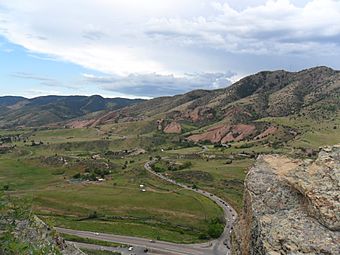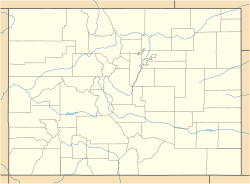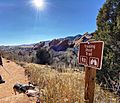Red Rocks Park facts for kids
|
Red Rocks Park District
|
|

Red Rocks area from Dakota Ridge
|
|
| Location | Morrison, Colorado |
|---|---|
| Area | 659 acres (267 ha) (landmarked area) |
| Built | 1928 |
| Architect | Hoyt, Burnham; Rosche, W. R. |
| Architectural style | Pueblo |
| MPS | Denver Mountain Parks MPS |
| NRHP reference No. | 90000725 |
Quick facts for kids Significant dates |
|
| Added to NRHP | May 18, 1990 |
| Designated NHL | August 4, 2015 |
Red Rocks Park is a special mountain park in Jefferson County, Colorado. The city of Denver owns and takes care of it as part of the Denver Mountain Parks system. This park is famous for its huge red sandstone rocks. Many of these rock formations have cool names, like the mushroom-shaped "Seat of Pluto" or the tilted "Cave of the Seven Ladders." The most visited rocks, found near Red Rocks Amphitheatre, are "Creation Rock" to the north, "Ship Rock" to the south, and "Stage Rock" to the east.
Contents
How Red Rocks Formed
The red sandstone you see at Red Rocks Park is part of something called the Fountain Formation. You can find other examples of this rock formation in Colorado at places like Roxborough State Park, Garden of the Gods near Colorado Springs, and the Flatirons near Boulder.
These rocks started forming about 290 to 296 million years ago. Back then, there were huge mountains called the Ancestral Rocky Mountains. Over time, these mountains wore down, and their pieces turned into the sandstone. Much later, a big movement of the Earth's crust, called the Laramide orogeny, pushed and tilted these rocks. That's why they stand at the angle you see them today.
A Look Back: History of Red Rocks
An Army group led by Stephen Long first explored the Red Rocks area in 1820. Long ago, the Ute tribe loved to camp here because the big rocks offered natural shelter from the weather.
The park's earliest known name was the Garden of the Angels. A Colorado judge named Martin Van Buren Luther supposedly gave it this name on July 4, 1870. In 1872, Marion Burts became the first person recorded to own Red Rocks. He later sold it to Leonard H. Eicholtz, a civil engineer who helped build the Union Pacific Railway. Eicholtz turned the property into a park in 1878. He added roads, trails, picnic spots, steps, and ladders to help visitors explore.
In 1906, Eicholtz sold Red Rocks to a famous editor named John Brisben Walker. Walker used money from selling his Cosmopolitan magazine to buy the park. He even started holding concerts on a temporary stage there. Even though people had called it "Red Rocks" for a long time, the name became official when Denver bought the park from Walker in 1928.
Red Rocks Amphitheatre
Inside the park is the famous Red Rocks Amphitheatre. This amazing outdoor music venue has been used since 1941. Burnam Hoyt designed the Amphitheatre to fit perfectly between two giant red rock slabs: Ship Rock and Creation Rock. It's known for its incredible natural acoustics and stunning views.
Building the Park
Denver Mayor Ben Stapleton initially didn't want to change the already beautiful Red Rocks. However, the city used money and workers from the New Deal programs during the Great Depression to build up the park. This was part of a bigger plan to develop the Denver Mountain Parks system.
City planner George Cranmer was in charge of this project. He got money from the government and set up a Civilian Conservation Corps (CCC) camp at Mount Morrison. The CCC was a program that put young men to work on public projects. These CCC crews built the first roads and the amphitheater. They also built a concession stand in the Pueblo style, which is a type of architecture. The park and the well-preserved CCC camp were recognized as a National Historic Landmark in 2015.
Exploring the Trails
Red Rocks Park has several trails for you to explore!
- Some trails are just for walking, like the Funicular Trail, Geologic Overlook Trail, Mt. Vernon Creek Trail, Red Rocks Trail, and the Trading Post Trail.
- Other trails are open for different activities, including mountain biking, horseback riding, and walking with leashed dogs.
Images for kids
See also
 In Spanish: Red Rocks Park para niños
In Spanish: Red Rocks Park para niños











